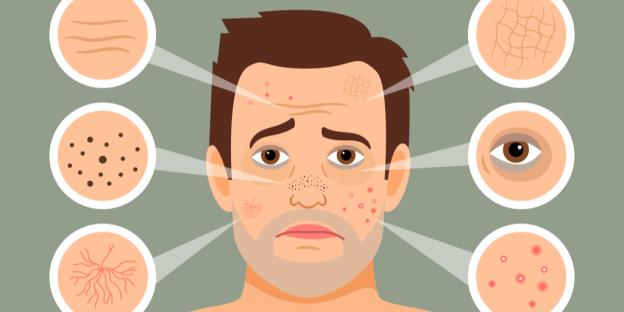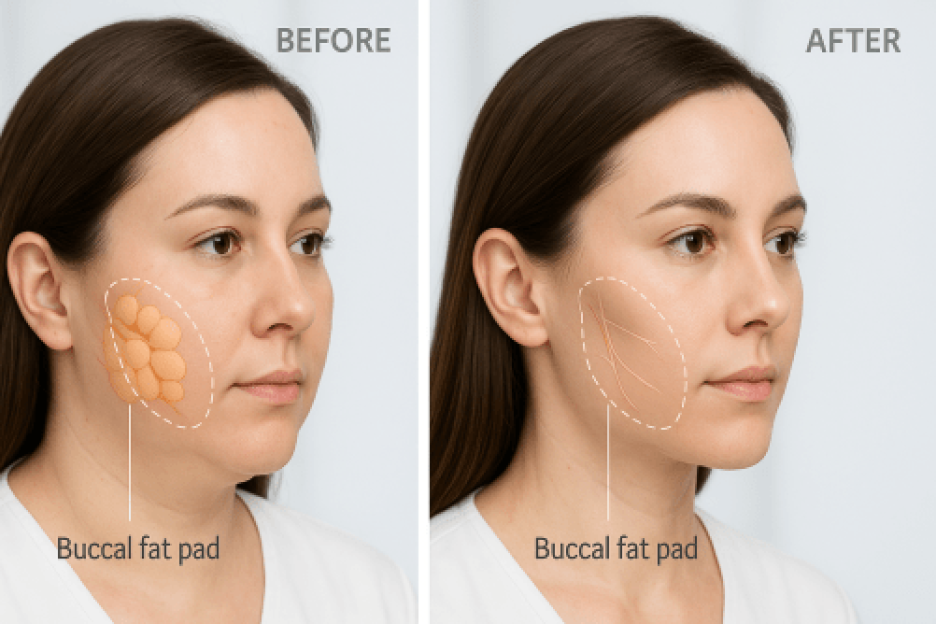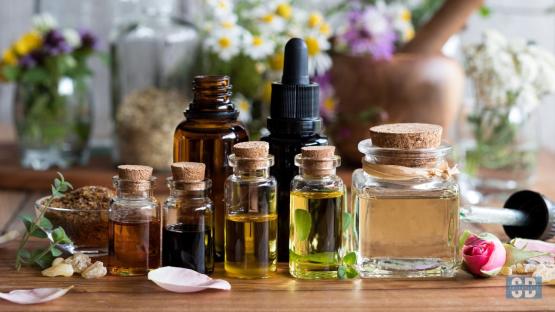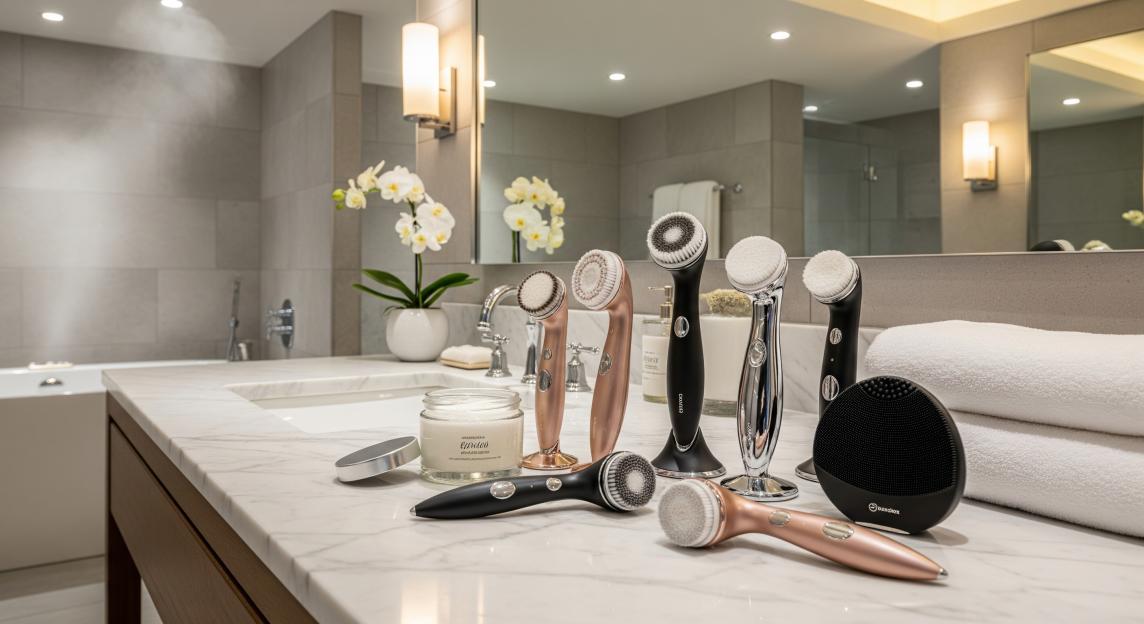Have you ever looked in the mirror and found an unexpected pimple staring back at you, even though your teenage years are long gone? If so, you’re not alone. Adult acne in men is a common yet often misunderstood skin condition that affects millions of American men well into their 30s, 40s, and beyond.
While we often associate acne with adolescence, the reality is that adult acne can be just as frustrating and persistent. The good news? Understanding the causes and implementing effective treatments can help you regain control of your skin and confidence.
In this comprehensive guide, we’ll explore everything you need to know about adult acne in men â from what triggers breakouts to the most effective treatment options and prevention strategies.
Understanding Adult Acne in Men: More Common Than You Think
Acne isn’t just a teenage problem. Studies show that approximately 42.5% of men in their 20s, 20.1% in their 30s, and 12% in their 40s deal with acne regularly. While women experience adult acne more frequently, men face unique challenges due to hormonal differences, skincare habits, and lifestyle factors that can trigger or worsen breakouts.
Adult acne in men typically appears as:
- Blackheads (open comedones)
- Whiteheads (closed comedones)
- Papules (small, red, tender bumps)
- Pustules (papules with pus at their tips)
- Nodules (large, solid, painful lumps beneath the skin)
- Cystic lesions (painful, pus-filled lumps beneath the skin)
These breakouts commonly affect the face, particularly the chin, cheeks, and forehead, but can also appear on the neck, back, chest, and shoulders â areas with a higher concentration of oil glands.
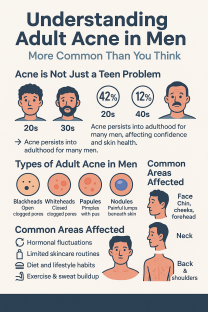
What Causes Adult Acne in Men?
Understanding what triggers your breakouts is the first step toward effective treatment. Here are the primary factors behind adult acne in men:
1. Hormonal Fluctuations
Testosterone, the primary male hormone, plays a significant role in acne development. Higher testosterone levels increase sebum (oil) production, which can clog pores and create an environment where acne-causing bacteria thrive.
Men may experience hormonal acne during:
- Stress periods (which increase cortisol production)
- After intense workouts (temporary testosterone spikes)
- During andropause (male hormonal changes in later years)
2. Genetics
If your parents or siblings struggled with adult acne, you might be more susceptible as well. Family history significantly influences your skin’s oil production, pore size, and overall reactivity to acne triggers.
3. Stress and Lifestyle Factors
Modern life creates perfect conditions for acne to flourish:
- Chronic stress increases cortisol levels, triggering inflammation and excess oil production
- Irregular sleep patterns disrupt hormonal balance
- Poor diet, particularly high-glycemic foods and excessive dairy consumption, can worsen acne
- Environmental pollutants clog pores and create oxidative stress on skin
4. Skincare and Grooming Habits
Men’s grooming routines can sometimes aggravate acne:
- Harsh shaving techniques that irritate skin
- Comedogenic (pore-clogging) beard oils or hair products
- Inadequate cleansing after workouts
- Using pore-clogging moisturizers or sunscreens
5. Medication Side Effects
Certain medications can trigger or worsen acne, including:
- Steroids (including those used by bodybuilders)
- Lithium
- Some anti-seizure medications
- Certain testosterone treatments
How Adult Acne Differs in Men vs. Women
Men and women experience adult acne differently due to biological and lifestyle factors:
- Oil production: Men typically produce more sebum due to higher testosterone levels
- Skin thickness: Male skin is about 25% thicker with larger pores
- Hormonal patterns: Women often experience cyclical breakouts tied to menstrual cycles, while men’s breakouts may be more consistent
- Treatment response: Men sometimes respond more quickly to treatments targeting oil production
Effective Treatments for Adult Acne in Men
Treating adult acne requires patience and consistency. Here are the most effective treatment approaches:
Over-the-Counter Solutions
For mild to moderate acne, these active ingredients can be highly effective:
1. Benzoyl Peroxide (2.5-5%)
- Kills acne-causing bacteria
- Reduces inflammation
- Works best for inflammatory acne (red, painful bumps)
- Apply a thin layer to entire acne-prone areas, not just active breakouts
- Start with lower concentrations to minimize irritation
2. Salicylic Acid (1-2%)
- Unclogs pores by exfoliating inside the pore lining
- Reduces blackheads and whiteheads
- Works well for oily skin types
- Available in cleansers, toners, and spot treatments
3. Retinol
- Increases cell turnover
- Prevents clogged pores
- Reduces inflammation
- Start with lower concentrations (0.25-0.5%) and use every other night initially
- Bonus: Also fights signs of aging
4. Niacinamide
- Reduces inflammation
- Regulates oil production
- Strengthens skin barrier
- Well-tolerated by most skin types
Prescription Treatments
For persistent or severe acne, consult a dermatologist who might recommend:
1. Prescription-Strength Retinoids
- Tretinoin, adapalene, or tazarotene
- More potent than over-the-counter retinol
- Significantly improves all forms of acne
2. Topical or Oral Antibiotics
- Reduces acne-causing bacteria and inflammation
- Often prescribed alongside benzoyl peroxide to prevent bacterial resistance
- Common options include clindamycin (topical) or doxycycline (oral)
3. Isotretinoin (Accutane)
- Reserved for severe, cystic acne that hasn’t responded to other treatments
- Highly effective but requires close medical supervision
- Reduces oil production, kills bacteria, and decreases inflammation
4. Anti-Androgen Medications
- Less commonly used in men due to potential side effects
- May be considered in certain cases under careful medical supervision
In-Office Procedures
Professional treatments can complement home care:
- Chemical peels: Remove dead skin cells and unclog pores
- Blue light therapy: Targets and kills acne-causing bacteria
- Extraction procedures: Professional removal of deep-seated blackheads
- Steroid injections: Rapidly reduce inflammation in large, painful cysts
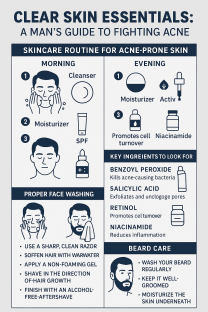
Creating an Effective Skincare Routine for Acne-Prone Men
Building a consistent skincare routine is essential for managing adult acne. Here’s a simple but effective regimen:
Morning Routine
- Cleanse: Use a gentle foaming cleanser with salicylic acid or benzoyl peroxide
- Treat: Apply targeted acne treatment (benzoyl peroxide or salicylic acid)
- Moisturize: Use a lightweight, oil-free, non-comedogenic moisturizer
- Protect: Apply broad-spectrum SPF 30+ sunscreen (gel formulations work well for oily skin)
Evening Routine
- Cleanse: Thoroughly remove day’s oil, sweat, and pollutants
- Treat: Apply retinol or prescription retinoid (alternate with other actives if using multiple treatments)
- Moisturize: Apply slightly richer (but still non-comedogenic) night moisturizer
Special Considerations for Men with Beards
- Use a gentle cleanser to wash beard area thoroughly
- Consider using a beard brush to exfoliate skin beneath facial hair
- Choose non-comedogenic beard oils (jojoba, argan, or grapeseed oil bases)
- Regularly clean beard trimmers and razors to prevent bacterial transfer
Shaving Tips for Acne-Prone Skin
Shaving can be particularly challenging for men with acne. Here’s how to minimize irritation:
- Prepare properly: Wash face with warm water and cleanser before shaving
- Use quality products: Select shaving creams formulated for sensitive skin (not gels)
- Technique matters: Shave in the direction of hair growth with minimal pressure
- Equipment care: Replace blades regularly and clean razors after each use
- Post-shave care: Apply alcohol-free aftershave or soothing aloe vera gel
Diet and Lifestyle Changes to Combat Adult Acne
What you eat and how you live significantly impacts your skin health:
Dietary Adjustments
- Reduce high-glycemic foods: Cut back on white bread, sugary drinks, and processed snacks
- Moderate dairy intake: Especially milk and whey protein supplements
- Increase omega-3 fatty acids: Found in fatty fish, flaxseeds, and walnuts
- Add antioxidant-rich foods: Colorful fruits and vegetables fight inflammation
- Stay hydrated: Aim for at least 8 glasses of water daily
Lifestyle Modifications
- Manage stress: Try meditation, regular exercise, or deep breathing techniques
- Improve sleep quality: Aim for 7-8 hours of quality sleep nightly
- Exercise wisely: Shower promptly after workouts to remove sweat
- Don’t touch your face: Hands transfer bacteria to acne-prone skin
- Clean items that touch your face: Regularly wash pillowcases, phone screens, and hats
When to See a Dermatologist
While many men can manage mild acne with over-the-counter treatments, certain situations warrant professional help:
- Acne that persists despite 2-3 months of consistent treatment
- Painful, deep cysts or nodules
- Acne that leaves scars or dark spots
- Suddenly severe breakouts in adulthood
- Acne accompanied by unusual symptoms like facial hair changes or weight fluctuations
A board-certified dermatologist can provide personalized treatment plans, prescription-strength medications, and advanced procedures not available over the counter.
The Psychological Impact of Adult Acne in Men
Adult acne can significantly affect self-confidence and mental wellbeing:
- Up to 70% of acne patients report social anxiety related to their skin
- Men often feel reluctant to discuss skin concerns or seek treatment
- Workplace confidence and social relationships can suffer
Remember that seeking treatment isn’t vainâit’s self-care. Many effective solutions exist, and addressing acne can improve both physical and psychological health.
Myths About Adult Acne in Men
Let’s clear up some common misconceptions:
Myth 1: Only teenagers get acne Reality: Acne affects people of all ages, with many men experiencing it well into their 30s, 40s, and beyond.
Myth 2: Acne means you’re not clean enough Reality: Over-washing can actually worsen acne by irritating skin and triggering more oil production.
Myth 3: Sunlight clears up acne Reality: While temporary improvement might occur, sun damage can worsen acne long-term and increase scarring risk.
Myth 4: All moisturizers cause breakouts Reality: Oil-free, non-comedogenic moisturizers are essential for balanced, healthy skin.
Myth 5: Diet doesn’t affect acne Reality: Growing evidence links high-glycemic foods and certain dairy products to increased breakouts.
Prevention Strategies: Keeping Adult Acne at Bay
Once you’ve gotten acne under control, these strategies can help prevent recurrence:
- Maintain your skincare routine: Even when skin clears, continue with preventive care
- Identify and avoid triggers: Keep a skin journal to track breakout patterns
- Stay consistent with treatments: Don’t stop prescription medications without consulting your doctor
- Seasonal adjustments: Modify your skincare routine as needed for summer humidity or winter dryness
- Regular check-ins: Consider periodic dermatologist visits to maintain results
The Bottom Line on Adult Acne in Men
Adult acne may be common, but it doesn’t have to be your normal. With the right understanding of causes, effective treatment approaches, and consistent prevention strategies, most men can achieve clearer, healthier skin.
Remember that treating acne takes timeâtypically 6-12 weeks to see significant improvement. Be patient with the process and consistent with your routine. If over-the-counter treatments aren’t yielding results after 2-3 months, don’t hesitate to consult a dermatologist for more advanced options.
Your skin deserves professional care, just like any other aspect of your health. With today’s improved understanding and treatment options, there’s no reason to let adult acne impact your confidence or quality of life.
Have you dealt with adult acne? What treatments worked best for you? Share your experience in the comments below!
This article is for informational purposes only and does not constitute medical advice. Always consult with a healthcare provider for diagnosis and treatment of medical conditions.
